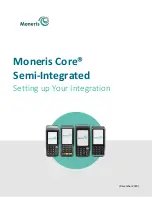
62
ISDN TA/V
If the call is answered by an ISDN TA/V, it begins to evaluate the type of
ISDN TA/V to which it is connected, the transmission protocol to be used,
and whether the remote ISDN TA/V will permit error correction, data
compression, etc.
Once this ISDN TA/V handshaking has finished, the outcome is reported
back to the computer in the form of a coded message. The front panel LCD
reports the line speed, accompanied by a statement of the error correction
type in use. For example,
Connected 64Kbps V.42
indicates a line speed of
64000 bps using V.42 error correction. This LCD message is also echoed to
your computer screen.
13.2 Using the Number Directory
Your ISDN TA/V uses a segment of its non-volatile memory to store up to
twenty frequently used ISDN numbers, and each storage location can hold
a maximum of 20 characters. Any one of these storage locations can later
be recalled, and the number dialed automatically.
13.2.1 S
TORING A
N
UMBER IN
O
NE OF THE
D
IRECTORY
L
OCATIONS
Assuming that your ISDN TA/V is in command mode (your computer is in
terminal emulation and the ISDN TA/V is off-line) the command
&Zn=x
is
used to identify the directory location and ISDN number to be stored. For
example:
AT&Z6=12345678<CR>
will store in directory location 6 the number 12345678, and similarly:
AT&Z2=87654321<CR>
will store in directory location 2 the number 87654321.
13.2.2 D
ISPLAYING THE
D
IRECTORY
C
ONTENTS
The contents of your number directory can be displayed using the
&N
command. We strongly advise that you use this command to check that all
stored numbers have been programmed correctly.
AT&N<CR>
Содержание IS300AE
Страница 7: ...8 ISDN TA V Part I Getting Started ...















































